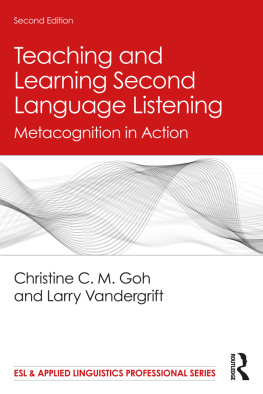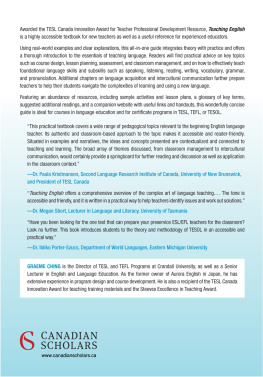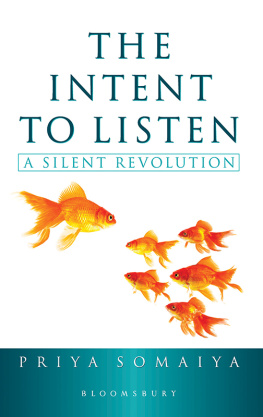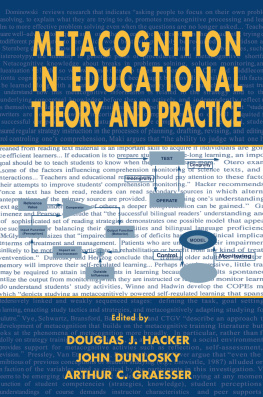The authors and publishers thank the following for permission to reproduce in whole or in part the following figures and tables:
Taylor and Francis Group, LLC, a division of Informa plc
, copyright 2011, from Handbook of Research in Second Language Teaching and Learning, Volume 2 by E. Hinkel (Ed.).
, copyright 2006, from Development and validation of the Imhof-Janusik listening concepts inventory to measure listening conceptualization differences between cultures. Journal of International Communication Research, 35, 7998, by M. Imhof and L. Janusik.
Wiley-Blackwell Publishers
, copyright 1997, from The Cinderella of communication strategies: receptive strategies in interactive listening. Modern Language Journal, 90, 338352, by L. Vandergrift.
, copyright 2006, from The Metacognitive Awareness Listening Questionnaire (MALQ): Development and validation. Language Learning, 56, 431462, by L. Vandergrift, C. Goh, C. Mareschal, and M. H. Tafaghodtari.
Mouton De Gruyter Publishers
, copyright 1993, from Language use in normal speakers and its disorders by W. J. M. Levelt. In G. Blanken, J. Dittmann, H. Grimm, J. C. Marshall, and C.-W. Wallesch (Eds.), Linguistic disorders and pathologies (pp. 115).
University of Toronto Press
, copyright 2003, from From prediction through reflection: Guiding students through the process of L2 listening. Canadian Modern Language Review, 59, 425440, by L. Vandergrift.
Cambridge University Press
, copyright 2004, from Listening to learn or learning to listen? Annual Review of Applied Linguistics, 24, 325, by L. Vandergrift.
Many years of classroom teaching led each of us separately to recognize the importance of listening in language learning and to investigate the nature and role of learning strategies in listening comprehension. The results of our doctoral research, one in French second language classrooms in Canada and the other in English second language classrooms in Singapore, led to the same conclusion: learner metacognition plays a crucial role in learning to listen and understand another language. We became aware of each others work through our respective publications and that led to collaborative efforts, such as development of the Meta-cognitive Awareness of Listening Questionnaire (MALQ) and, eventually, this book. It is our hope that this book will help teachers around the world better understand the process of listening comprehension and become more effective in their efforts to develop successful language learners.
In writing this book, we have been encouraged and supported by many people. We would like to acknowledge:
- The support and encouragement of our respective families;
- The formative role of colleagues Anna Chamot, Andrew Cohen, David Mendelsohn, Rebecca Oxford, Joan Rubin, and Anita Wenden, and their encouragement of our work;
- The useful feedback from colleagues who have read one or more chapters: Albert Dudley, Patricia Dunkel, Bill Grabe, Volker Hegel-heimer, Amelia Hope, Catherine Mareschal, Rebecca Ranjan, and Alysse Weinberg;
- The help provided by Jose Lgar in creating, formatting, and revising figures and tables;
- The editorial support by Kathy Vandergrift, who helped make our writing clearer;
- The meticulous work by Karim Mekki in preparing the references and verifying all the details for manuscript submission; and
- The encouragement from Naomi Silverman and Eli Hinkel at Rout-ledge to embark on this book project.
Larry Vandergrift and Christine C. M. Goh (First Edition, 2012)
After the publication of the first edition in 2012, Larry Vandergrift and I were already talking about working on a second edition to improve it. The field of metacognition and second language listening was growing and many research studies had emerged, examining metacognition specifically and process-based instruction more generally. We were particularly heartened by the great interest that this book generated among fellow teacher educators and researchers. Between us, we responded to numerous emails from all over the world and spoke with many colleagues and students at international conferences. The idea of a second edition seemed ripe. Unfortunately, Larry left us in 2015. With the void in this partnership, the plan for the revision was set aside. When I finally decided to undertake the revision alone, Routledge was most supportive, and that eventually began the process of revision. I am pleased to present to you the second edition of this book. No doubt, this would have been a better version with Larry Vandergrift. Nevertheless, I believe that he would have been happy with it. I hope this book will continue to contribute to the field as the first edition has.
I have many people to thank for the completion of this edition, not least the many wonderful friends and colleagues acknowledged in the section above for the first edition, which laid the solid foundation for this second edition. In addition, I am deeply grateful to Kathy Vandergrift, and to Eli Hinkel, Naomi Silverman, and Karen Adler at Routledge for their encouragement and support in embarking on this edition. I would also like to thank Zhao Chunsheng for assisting me in the work. The National Institute of Education, NTU Singapore, provided a grant (RS119CG) that made this piece of work possible. Finally, my heartfelt gratitude goes to my family for cheering me on.
Christine C. M. Goh (Second Edition)
Appendix A
Strategies for L2 Listening Comprehension and Listening Development
| 1. Planning: |
| Developing awareness of what needs to be done to accomplish a listening task, developing an appropriate action plan and/or appropriate contingency plans to overcome difficulties that may interfere with successful completion of a task. |
| Advance organization: | - - I read over what we have to do.
- - I try to think of questions the teacher is going to ask.
- - I have 2 months to prepare for my listening paper.
- - I try to get in the frame of mind to understand French.
- - I put everything aside and concentrate on what she is saying.
- - I need to be more focused.
|
| Clarifying the objectives of an anticipated listening task and/or proposing strategies for handling it. |
| Self-management: |
| Understanding the conditions that help one successfully accomplish listening tasks and arranging for the presence of those conditions. |
| 2. Focusing attention: Avoiding distractions and heeding the auditory input in different ways, or keeping to a plan for listening development. |
| Directed attention: | - - Ilisten really hard.
- - I pick out the words that are familiar so that.
- - I try to concentrate on carrying out my plan.
- - I listen for the key words.
- - I pay special attention to adjectives.
- - Because I hear also, then I concentrate on the words after also.
|
| Attending in general to the listening task and to ignore distraction; maintaining attention while listening. |
| Selective attention: |
| Attending to specific aspects of language input or situational details that assist in understanding and/or task completion. |
| 3. Monitoring: Checking, verifying, or correcting ones comprehension or performance in the course of a task. |
| Comprehension monitoring: | - - Theres one word, I didnt hear. Er, the something is er, protects eyes, and some other I cant remember.
|








